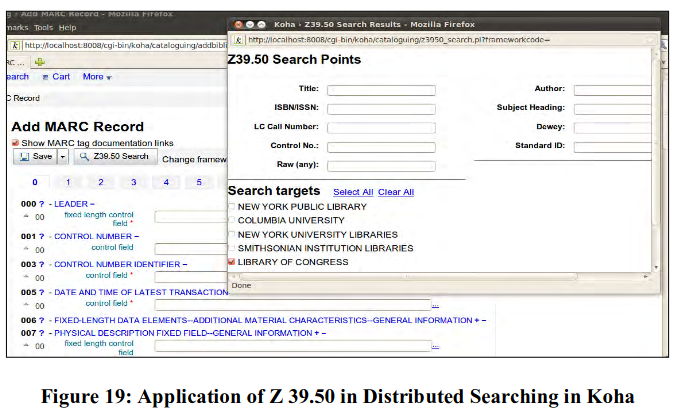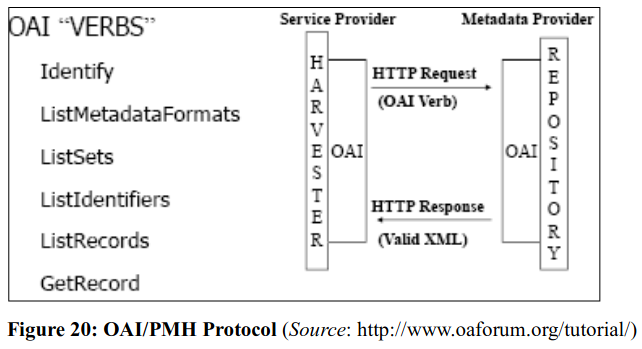2.4 Major Interoperability Standards
Order, collaboration and interoperability are three most important prerequisites for effective information services. All these requirements depend on effective standards. Library services have long depended on shared standards. The case of open access interoperability is no exception. ANSI defined a standard as a specification accepted by recognized authority as the most practical and appropriate current solution of a recurring problem. ISO/IEC Guide 2:2004 defines a standard as a document, established by consensus and approved by a recognized body, that provides, for common and repeated use, rules, guidelines or characteristics for activities or their results, aimed at the achievement of the optimum degree of order in a given context. In the area of interoperability, there are many initiatives to cover different areas with specifications and standards. However, three major interoperability standards are accepted widely by information professionals all over the world. These are Z 39.50 for distributed cataloguing, OAI/PMH for metadata harvesting and OAI-ORE for sharing compound digital objects.
2.4.1 Z 39.50
The ANSI/NISO standard Z39.50-2003 (Information Retrieval: Application Service Definition & Protocol Specification) is adopted widely by library systems, library automation software vendors, and digital library developers (such as Greenstone Digital Library Software) as a protocol for searching catalogue databases in different library systems and software across the globe. The retrieved results may be saved in desired format and may also be edited before inclusion in the local catalogue database. ISO and other major national SDOs adopted this standard widely in developing equivalent standards such as IS 15390:2003 (by the Bureau of Indian Standards) and ISO 23950:1998 (by ISO). Z39.50 was developed over Open System Interaction (OSI) protocol. It is basically a program-to-protocol and divided into two parts – client (called an ‘origin’ in the standard) and server (called a ‘target’ in the standard). Z39.50 supports most of the major MARC formats and can operate over WWW through http- Z39.50 gateway.

A Z39.50 service can be implemented in libraries in diverse ways. It can offer library resources through Z39.50 server and by using Z39.50 client software, a library can go for intersystem searching and bibliographic record transfer irrespective of different hardware and software (See Figure19). Considering the endless advantages of Z39.50 protocol, modern LMSs are incorporating Z39.50 client protocol suite in the catalogue module. Z 39.50 standard is now being replaced by emerging interoperability standards like SRU/SRW82(Search and Retrieve URL/Web Service - Web services for search and retrieval based on Z39.50, developed by Library of Congress) and ZING (Z39.50-International: Next Generation covers a number of initiatives by Z39.50 implementers to make the semantic content more broadly available).
2.4.2 OAI/PMH
TheOAI/PMH is a light-weight standard protocol developed by Open Archive Initiative (OAI) for harvesting metadata records from ‘data providers’ to ‘service providers’. It provides a set of rules to harvest metadata of knowledge objects from a repository not the full-text objects. The full-text resource may be retrieved form source repository or data provider. There are two groups of operators in the OAI-PMH framework:
- Service Providers use metadata harvested via the OAI-PMH as a basis for building value-added services; and
- Data Providers administer systems that support the OAI-PMH as a means of exposing metadata.
At the time of harvesting, service providers send requests to other repository i.e. data provider in the form of OAI/PMH verbs (request type). The OAI/PMH includes Six Verbs and these are:
- Identify (return general information about the archive and its policies);
- ListSet (provide a listing of sets in which records may be organized);
- ListMetadataFormats (list metadata formats supported by the archive as well as their schema locations and namespaces);
- ListIdentifiers (list headers for all items corresponding to the specified parameters);
- GetRecord (returns the metadata for a single item in the form of an OAI record); and
- ListRecord (retrieves metadata records for multiple items).
Service provider can get specific type of metadata by GetRecord and ListRecord. The request is transferred on the basis of the rule of HTTP over the Web (see Figure 20).

OAI/PMH is a matured interoperability standard now. Almost all the OA repository software are compliant with this standard. It is also applied for harvesting usage data by the initiatives like KE-USG, NEEO and OA-Statistik. Many open source harvesting software are also compliant with OAI/PMH.
2.4.3 ORE
You already know that OAI-ORE, as an interoperability standard for compound digital objects, aims to provide solution that supports aggregations of Web resources. Open Archives Initiative (OAI) - Object Reuse and Exchange (ORE) is an open interoperability standard developed by Open Archive Initiative. OAI-ORE standardizes the description of the relationship between digital objects. This relationship could be between versions of an object, such as might be found in a repository record, or aggregations of objects, such as a Web page with images, or a collection of chapters in a book.
The OAI-ORE standard has four basic components to support web aggregation.
- OAI-ORE Model: The model advocated using RDF model to annotate objects with metadata at the repository level to support semantic web technologies like Linked Data and Cool URI.
- Aggregations: Alongside the RDF model, OAI-ORE specifies the concept of Web Aggregations and Aggregated Digital Resources (an Aggregation is simply a set of Aggregated Resources, all of which are represented by URIs.)
- Resource Maps: The next level of the standard suggests Resource Map. A Resource Map describes a single Aggregation with unique URI. In OAI-ORE model a Resource Map can only link to a single Aggregation in the OAI-ORE model.
- Representations: A Resource Map in the ORE standard requires representation for interoperability. This can be done in two ways (as prescribed by OAI-ORE) – i) RDF/XMLSerialization; and ii) Atom/XML Serialization.
OAI-ORE is an operational standard and can be used to transfer resources from one repository software to another. For example both EPrints and Fedora (two reputed open source repository software platforms) are now compliant with OAI-ORE by applying OAI-ORE plug-ins in terms of cross-system import and export of compound digital objects.
2.4.4 Others
The other interoperability standards (related directly or indirectly with open access interoperability issues), developed by Standard Development Organizations (SDOs), National Libraries and Library Associations are (illustrative list not comprehensive)
- ISO 10957:1993 (Information and documentation -- International standard music number (ISMN))
- ISO 15706-1:2002 (Information and documentation -- International Standard Audiovisual Number) (ISAN) -- Part 1: Audiovisual work identifier);
- ISO 15706-2:2007 (Information and documentation -- International Standard Audiovisual Number (ISAN) -- Part 2: Version identifier);
- ISO 2108:2005 (Information and documentation -- International standard book number (ISBN));
- ISO 21127:2006 (Information and documentation -- A reference ontology for the interchange of cultural heritage information);
- ISO 3297:2007 (Information and documentation -- International standard serial number (ISSN))
- ISO 3901:2001 (Information and documentation -- International Standard Recording Code (ISRC))
- ISO/AWI TR 19934 (Information and documentation -- Statistics for the use of electronic library services);;
- ISO/CD 27729(Information and documentation -- International Standard Party Identifier (ISPI));
- ISO/CD TR 26102 (Information and documentation -- Requirements for long-term preservation of electronic records)
- ISO/CD 26324 for Digital Object Identifier system;
- ISO/NP 27730 (Information and documentation -- International standard collection identifier (ISCI));
- ISO/TR 21449:2004 (Content Delivery and Rights Management: Functional requirements for identifiers and descriptors for use in the music, film, video, sound recording and publishing industries);
- ISO/TR 21449:2004 (Content Delivery and Rights Management: Functional requirements for identifiers and descriptors for use in the music, film, video, sound recording and publishing industries);
- ISO/TR 26122:2008(Information and documentation -- Work process analysis for records);
- MADS (Metadata Authority Description Standard) - XML markup for selected authority data from MARC21 records as well as original authority data ;
- METS (Metadata Encoding & Transmission Standard) - Structure for encoding descriptive, administrative, and structural metadata;
- MODS (Metadata Object Description Standard) - XML markup for selected metadata from existing MARC 21 records as well as original resource description
- SRU/SRW (Search and Retrieve URL/Web Service) - Web services for search and retrieval based on Z39.50;
- Z39.53 (Codes for the Representation of Languages for Information Interchange);
- Z39.56 (Serial Item and Contribution Identifier (SICI)).
- Z39.93 (The Standardized Usage Statistics Harvesting Initiative (SUSHI) Protocol);
The interoperability standards are originated from two groups of activities – i) cooperative standards developed by learned societies, library associations and national libraries; and ii) standards developed by national and international standard organizations (like ISO, NISO, BSI etc). The cooperative interoperability standards are open standards. The W3C (2006) provides a set of six pack criteria in definingOpen Standards - transparency (due process is public, and all technical discussions, meeting minutes, are archived and citable in decision making), relevance (new standardization is started upon due analysis of the market needs, including requirements phase, e.g. accessibility, multilingualism), openness (anybody can participate, and everybody does: industry, individual, public, government bodies, academia, on a worldwide scale), impartiality and consensus(guaranteed fairness by the process and the neutral hosting of the W3C organization, with equal weight for each participant), availability (free access to the standard text, both during development and at final stage, translations, and clear IPR rules for implementation, allowing open source development in the case of Web technologies) and maintenance (ongoing process for testing, errata, revision, permanent access).
